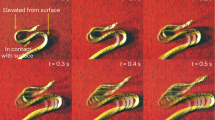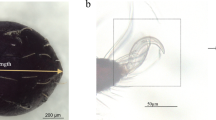Abstract
IT is a well known fact that the pythons and boas and some allied forms among snakes possess rudiments of hind limbs, these vestiges—to quote Boulenger's “Catalogue of Snakes in the British Museum”—“usually terminating in a claw-like spur visible on each side of the vent.” These structures are always mentioned in general works upon Ophidia, such as Hoffmann's account of the serpents in vol. vi. of Bronn's “Klassen und Ordnungen des Thierreichs,” and Gadow's “Reptiles and Amphibians” in the “Cambridge Natural History.” But in none of the three treatises to which I refer is there any further account of the “claws” or “spurs.” It is merely stated that they are present. It is not mentioned in these works, nor in some others which I have consulted, that the claws in question offer valuable sexual characters by the aid of which individuals can be referred to their proper sex, at least in certain Boidæ. The fact that these characters have been so largely overlooked is perhaps due to the slight stress laid upon them by Duméril and Bibron (Erpétologie Générale, vol. vi., 1844), who, however, did direct attention to the occurrence of differences, in these organs between the two sexes in a number of Boidæ. But they speak of the claws merely as being “d'une très petite dimension chez des femelles,” and as “plus développès chez les males que chez les femelles.” The first of these quotations refers to Eunectes, the second to Boa. The differences, however, in Eunectes notaeus are greater. In this southern anaconda, of which several specimens were lately deposited in these gardens by the Hon. Walter Rothschild, there is in the male a sharp curved claw turned downwards and ridged along its lower surface. In the female, on the other hand, the representative of this claw is not a claw at all strictly speaking—if, that is to say, we mean by a claw a nail-like structure which is curved and compressed and ends in a sharp point. In the female there is a straight, blunt, horny process distinctly unlike the sharp claw of the male. In two young examples of this anaconda, which are females, the same type of horny structure is found as in the adult female. In the allied genus Eryx there are still greater differences between the two sexes.
This is a preview of subscription content, access via your institution
Access options
Subscribe to this journal
Receive 51 print issues and online access
$199.00 per year
only $3.90 per issue
Buy this article
- Purchase on SpringerLink
- Instant access to full article PDF
Prices may be subject to local taxes which are calculated during checkout
Similar content being viewed by others
Author information
Authors and Affiliations
Rights and permissions
About this article
Cite this article
BEDDARD, F. The Rudimentary Hind Limbs of the Boine Snakes. Nature 72, 630 (1905). https://doi.org/10.1038/072630a0
Issue date:
DOI: https://doi.org/10.1038/072630a0



